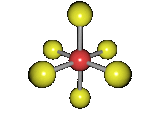The Lewis Structure
From the tutorial on periodicity (Experiment #2) you learned that the three particles that form the atom are the proton, the neutron, and the electron. While the protons and the neutrons are responsible for the mass of the atom, it is the electron that is responsible for its reactivity.
There are two types of electrons that are present within the atom: core electrons and valence electrons. Core electrons are electrons which are held close to the nucleus and do not take part in chemical bonding. Valence electrons are electrons that are present in the outermost unfilled  shell of the atom. These electrons are responsible for the properties and reactivity of an element. Reactivity refers to how a substance responds in the presence of another substance under a set of conditions. For example, in a chemical reaction atoms from different substances will rearrange and combine (bond) to form new substances (a bond is an attraction that forms between two atoms). This attraction is due to the interaction of the valence electrons in those atoms. Representing a structure for a substance as a result of the interaction between their valence electrons is the basis for the Lewis Structure.
shell of the atom. These electrons are responsible for the properties and reactivity of an element. Reactivity refers to how a substance responds in the presence of another substance under a set of conditions. For example, in a chemical reaction atoms from different substances will rearrange and combine (bond) to form new substances (a bond is an attraction that forms between two atoms). This attraction is due to the interaction of the valence electrons in those atoms. Representing a structure for a substance as a result of the interaction between their valence electrons is the basis for the Lewis Structure.
![]()